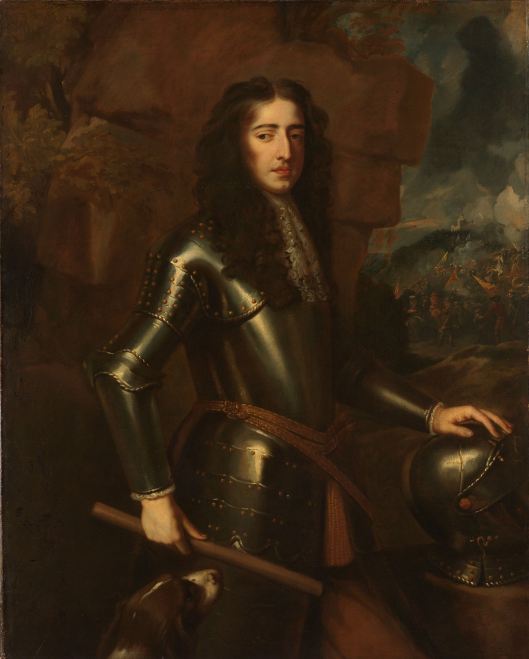Tags
Catherine de Braganza of Portugal, Duke of York, English Civil War, King Charles I of England, King Charles II of England, King Henri IV of France and Navarre, King Joâo IV of Portugal, Maria de Medici, Oliver Cromwell, Prince James, Restoration, Scotland and Ireland
Charles II (May 29, 1630 – February 6, 1685) was King of Scotland from 1649 until 1651 and King of England, Scotland, and Ireland from the 1660 Restoration of the monarchy until his death in 1685.
King Charles II was the eldest surviving child of King Charles I of England, Scotland and Ireland and Henrietta Maria de Bourbon of France, the daughter of King Henri IV of France and Navarre and Marie de’ Medici.
After King Charles I’s execution at Whitehall on 30 January 1649, at the climax of the English Civil War, the Parliament of Scotland proclaimed Charles II king on February 5, 1649.
However, England entered the period known as the English Interregnum or the English Commonwealth, with a government led by Oliver Cromwell. Cromwell defeated King Charles II at the Battle of Worcester on September 3, 1651, and Charles fled to mainland Europe.
Cromwell became Lord Protector of England, Scotland and Ireland. Charles spent the next nine years in exile in France, the Dutch Republic and the Spanish Netherlands.
The political crisis that followed Cromwell’s death in 1658 resulted in the restoration of the monarchy, and Charles was invited to return to Britain. On May 29, 1660, his 30th birthday, he was received in London to public acclaim. After 1660, all legal documents stating a regnal year did so as if he had succeeded his father as king in 1649.
Negotiations with Portugal for Charles’s marriage to Catherine de Braganza of Portugal began during his father’s reign and upon the restoration, Queen Luísa of Portugal, acting as regent, reopened negotiations with England that resulted in an alliance.
Catherine was born at the Ducal Palace of Vila Viçosa as the second surviving daughter of João, 8th Duke of Braganza, and his wife, Luisa de Guzmán. Following the Portuguese Restoration War, her father was acclaimed King João IV of Portugal on December 1, 1640.
On June 23, 1661, a marriage treaty was signed; England acquired Catherine’s dowry of the port of Tangier in North Africa, the Seven Islands of Bombay in India (which had a major influence on the development of the British Empire), valuable trading privileges in Brazil and the East Indies, religious and commercial freedom in Portugal and two million Portuguese crowns (equivalent to £300,000 then); while Portugal obtained military and naval support against Spain and liberty of worship for Catherine.
Catherine journeyed from Portugal to Portsmouth on May 13–14, 1662, but was not visited by Charles there until 20 May 20. The next day the couple were married at Portsmouth in two ceremonies—a Catholic one conducted in secret, followed by a public Anglican service.
Following his restoration, Charles became known for his affability and friendliness, and for allowing his subjects easy access to his person. However, he also showed an almost impenetrable reserve, especially concerning his political agendas. His court gained a reputation for moral laxity. Charles’s marriage to Catherine of Braganza produced no surviving children, but the king acknowledged at least 12 illegitimate children by various mistresses.
Death
Charles suffered a sudden apoplectic fit on the morning of 2 February 1685, and died aged 54 at 11:45 am, four days later, at the Palace of Whitehall. The suddenness of his illness and death led to suspicion of poison in the minds of many, including one of the royal doctors; however, a more modern medical analysis has held that the symptoms of his final illness are similar to those of uraemia (a clinical syndrome due to kidney dysfunction).
King Charles II had a laboratory among his many interests, where prior to his illness he had been experimenting with mercury. Mercuric poisoning can produce irreversible kidney damage, but the case for this being a cause of his death is unproven.
In the days between his collapse and his death, Charles endured a variety of torturous treatments that included bloodletting, purging and cupping in hopes of effecting a recovery, which may have exacerbated his uraemia through dehydration instead of helping to alleviate it.
On his deathbed Charles asked his brother, James, the Duke of York, to look after his mistresses: “be well to Portsmouth, and let not poor Nelly starve”. He told his courtiers, “I am sorry, gentlemen, for being such a time a-dying”, and expressed regret at his treatment of his wife.
On the last evening of his life he was received into the Catholic Church in the presence of Father John Huddleston, though the extent to which he was fully conscious or committed, and with whom the idea originated, is unclear. He was buried in Westminster Abbey “without any manner of pomp” on February 14th.
King Charles II was succeeded by his brother as King James II of England and Ireland and as King James VII of Scotland.




